Choosing how to cover the onion for the winter from frost and studying the nuances of the process
What and how to cover onions for the winter - a question that is relevant for many summer residents. For this, both artificial materials (agrofibre, expanded clay, burlap) and organic (hay, sawdust, leaves, peat) are used - the latter retain heat, moisture well, allow air and sunlight to pass through.
The article will tell you how to properly cover plantings and what material to choose for onion beds.
The content of the article
Why cover onions for the winter
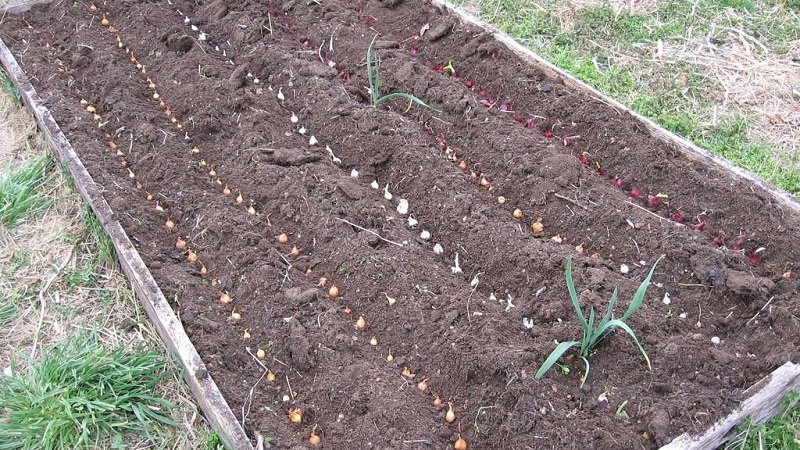
Insulation of winter beds will preserve crops and improve the characteristics of the future harvest. Correctly covered plants give early shoots. A layer of insulation not only saves from frost, but also helps the culture to cope with drastic climatic changes. If it suddenly gets warmer or it starts snowing with frost, then the plantings will not suffer.
Important! Do I need to cover the onions planted before winter in the southern regions? Here it is not necessary to do this: the further north the region, the more carefully the plants are insulated.
Why this procedure cannot be ignored
Do I need to cover the bow for the winter? The protective material creates a favorable microclimate for the growth and development of vegetables, prevents the soil from freezing.
The main advantages of the landing shelter:
- with the onset of frost, the onion does not freeze;
- the percentage of vegetable germination increases;
- bulbs accumulate strength for growth and develop actively in spring;
- weed growth slows down;
- shoots that appeared during the thaw do not die;
- the soil is not waterlogged;
- plants are protected from pests and diseases.
When to cover the beds
They insulate or mulch the beds on the day of sowing. Dates depend on the region and weather conditions.
Important! The bulbs should root first and not grow.
The optimum temperature for planting crops in open ground is + 10 ... + 12 ° C. The procedure is carried out 2-3 weeks before the first frost.
Onion planting dates before winter:
- middle band: from the beginning of the third decade of September to the second decade of October;
- northern regions, the Urals and Siberia: second decade of September - second decade of October;
- southern regions and Crimea: third decade of October - first decade of November.
How to cover the onion for the winter from frost
The choice of insulation depends on many factors:
- climate in the growing region;
- weather forecast for the winter;
- material availability;
- opportunities of the summer resident.
Agrofiber
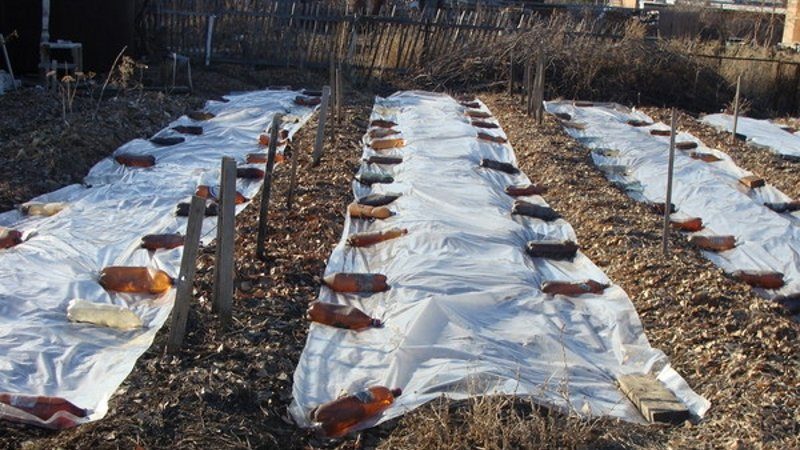
The material is a thin film made of propylene.
Advantages of agrofibre:
- keeps warm well;
- transmits sunlight;
- weighs little;
- durable, with careful use it lasts for 2-3 seasons.
Disadvantages:
- overheating of the soil at excessive temperatures;
- the formation of condensation inside, which leads to the development of diseases.
Agrofibre is used in regions with warm winters.
Peat
Peat is an excellent natural thermal insulation material. For insulation, a layer of 4 cm is enough.
Advantages:
- high thermal insulation properties;
- moisture retention.
Disadvantages:
- increases the acidity of the soil;
- dries, thickens and forms a crust;
- difficult to access.
Sawdust
Using sawdust from chipboard or other building materials will negatively affect onions due to the increased content of chemicals. Therefore, clean sawdust is chosen to protect vegetables.
Benefits:
- good thermal insulation;
- perfectly absorbs and retains moisture.
Disadvantages:
- from excess moisture, sawdust cakes and preserves;
- acidify the soil;
- in the spring they interfere with the heating of the soil.
Leaves
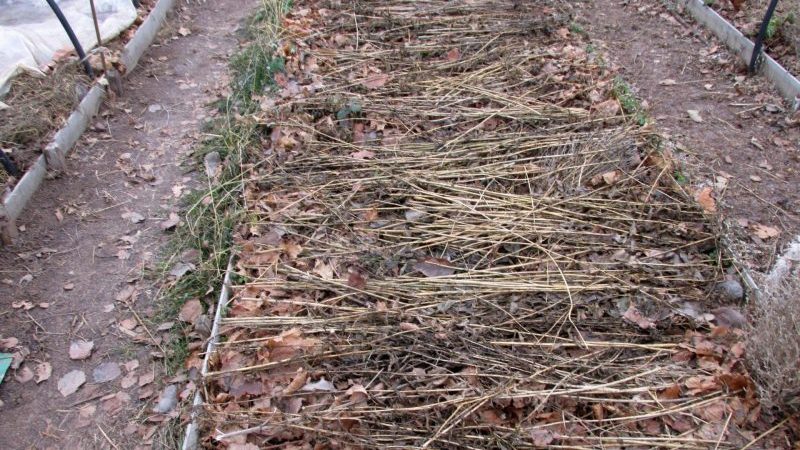
Maple or oak leaves are used to insulate plantings. Fruit trees are not suitable for these purposes: they often serve as a breeding ground for diseases and pests. Birch leaves die quickly.
Important! Dry the material before use.
Advantages:
- availability;
- high air permeability;
- heat retention.
Disadvantages:
- difficult to prepare;
- it is important to keep the foliage dry;
- at high humidity, the onion dries out;
- the material creates favorable conditions for the development of diseases and pests.
Hay
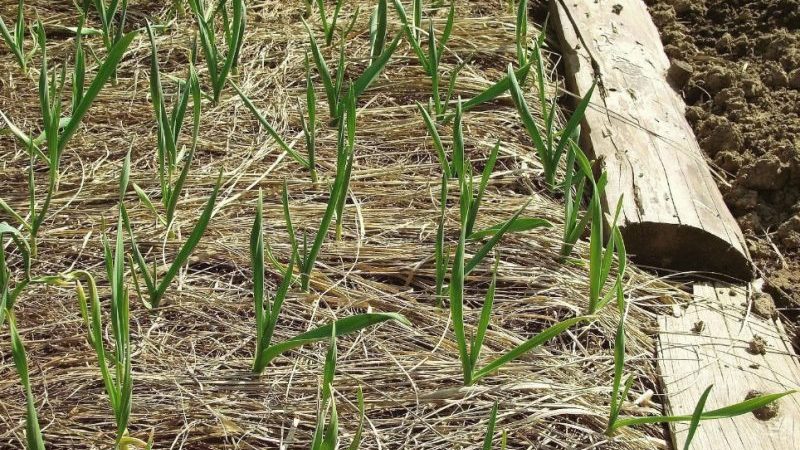
Hay is used only in dry form and always protected from moisture.
Benefits:
- high thermal insulation;
- protection of soil from waterlogging;
- slowing down the growth of weeds.
Disadvantages:
- when wet, the hay is strongly compacted and increases soil moisture;
- serves as a habitat for pests;
- with the onset of spring, the ground slowly warms up under a layer of grass.
Sackcloth
Burlap does an excellent job with the role of insulation. When choosing it, attention is paid to the composition of the fabric: synthetics do not allow air to pass through well, they do not regulate humidity.
Advantages:
- protects plantings from excess moisture;
- does not let the sun go through.
Disadvantages:
- the fabric dries for a long time and poorly, which contributes to damping;
- under the raw burlap diseases develop.
Expanded clay
It is a building material made from baked clay. Represents light oval stones. Expanded clay serves as a drainage, mulch and heat insulator for plants at the same time.
Benefits:
- high air permeability;
- protection of landings from soaking, decay, temperature changes.
The only drawback of expanded clay is its inaccessibility.
Stems
The stems will cover the plants if nothing is at hand. To do this, take dry and healthy plant residues without seeds.
Benefits:
- availability;
- high breathability.
Disadvantages:
- at high humidity, the stems are blown out;
- putrefactive diseases develop under the organic layer.
Brushwood
The brushwood does not so much retain heat as it retains the snow cover. That, in turn, protects the onion from frost and wind.
Advantages:
- does not melt;
- good air permeability;
- does not rot for a long time.
The brushwood does not have heat-shielding properties, therefore it is not used in the snowless winter.
Lapnik
This material is often used in forest regions where there are many branches of conifers.
Benefits:
- creates an additional air gap;
- keeps snow;
- scares off rodents;
- keeps warm.
Disadvantages:
- needles acidify the soil;
- often serves as a breeding ground for diseases and pests.
How to do it right
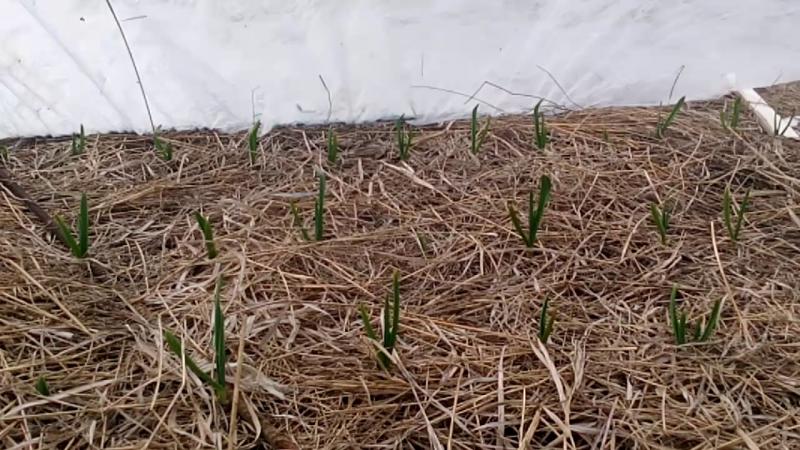
The use of covering materials in the complex will have a beneficial effect on the quality of the crop.
Stages of winter bow shelter:
- After sowing, the garden bed is mulched with any organic matter: peat, foliage, hay, sawdust.
- To prevent the mulch from being carried by the wind, dry branches or spruce branches are placed on top.
- In early spring, the shelter is removed. Do this as soon as the snow melts.
Useful Tips
There are many options for hiding winter onions, and each has advantages and disadvantages. Choose the material in accordance with the climate and remember the main condition: the shelter should protect vegetables from rotting, freezing and pests.
Recommendations from experienced gardeners:
- Do not use a film for cover: it is too dense and does not allow air to pass through. Due to low ventilation, condensation will accumulate, fungi will appear, turnips will rot.
- Don't forget about crop rotation. If you plant a crop after carrots, garlic, strawberries and other onions, pathogens and pests accumulated in the soil will destroy the entire crop.
- Observe the timing of the shelter. They depend on the sowing time and climatic characteristics of the region.
- Use environmentally friendly materials.
- In severe frosts or light snow cover, use several covering materials in combination.
It is interesting:
Why cut the onion when planting before winter and whether it needs to be done.
Conclusion
Onions are cold-resistant crops, but even it is important to protect them from winds and temperature changes in winter. The covering material is chosen taking into account the weather conditions in the growing region. If the winter is long, use foliage and brushwood together; if there is little snow, use agrofibre. Such measures increase the percentage of germination and the quality of the crop.